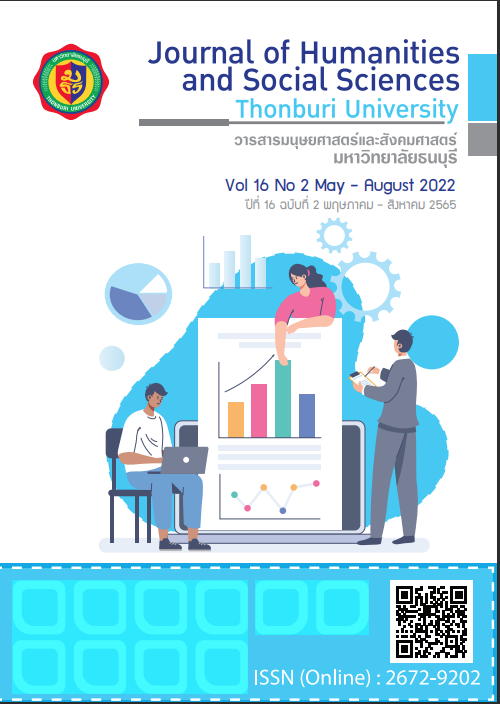Quality of Life of Thai Employees under COVID-19 Pandemic
Keywords:
Quality of life, Thai Employee, COVID-19 pandemicAbstract
This research aims to 1) study the level of quality of life of employees in Thailand during the novel coronavirus disease 2019 (COVID-19) epidemic, and 2) to compare the quality of life in terms of physical health, psychological health, social relationship, and environmental of government officers and private sector employee in Thailand in the situation of the novel coronavirus disease 2019 (COVID-19) by collecting data from 385 government officers and private sector employees in Thailand who cooperated in collecting data. From the results, it can be concluded that 1) overall, staff in Thailand have a moderate quality of life ( =3.62, SD=0.47). 2) Occupational variables (government officers and private sector employees) did not affect quality of life overall and in terms of physical health, psychological health, social relationship, and environmental with a statistically significant difference at 0.05 level.
References
Anderson, R.M.; Heesterbeek, H.; Klinkenberg, D.; Hollingsworth, T.D. (2020). How will country-based mitigation measures influence the course of the COVID-19 epidemic? Lancet. 395, 931–934.
Britannica. (2021) "Quality Of Life". Retrieved 15 January 2021. From https://www.britannica.com/topic/quality-of-life.
Cochran, W.G. (1953). Sampling Techniques. New York : John Wiley & Sons.
Department of Disease Control. (2020). Coronavirus disease 2019 (COVID-19). Retrieved March 10, 2021, from https://ddc.moph.go.th/viralpneumonia/file/introduction/introduction01.pdf
Department of Disease Control. (2021). Guidelines for the prevention of coronavirus disease 2019 (COVID-19) or COVID-19 for the general public and at risk groups. Retrieved March 10, 2021, From https://ddc.moph. go.th/viralpneumonia/file/int_protection/int_protection_030164.pdf
Department of Mental Health. (2002). World Health Organization Quality of Life Brief – Thai, WHOQOL-BREF-THAI). Retrieved March 10, 2021, from https://www.dmh.go.th/test/whoqol/
Drydakis, Nick. (2015). The effect of unemployment on self-reported health and mental health in Greece from 2008 to 2013: A longitudinal study before and during the financial crisis. Social Science & Medicine. 128.
Ferrans, C. E., & Powers, M. J. (1992). Psychometric assessment of the Quality of Life Index. Research in Nursing & Health, 15(1), 29–38.
Hair, J. F., Black, W. C., Babin, B. J., Anderson, R. E., & Tatham, R. L. (2010). Multivariate data analysis 7thed. New Jersey: Pearson Prentice Hall.
Hawryluck, L.; Gold, W.L.; Robinson, S.; Pogorski, S.; Galea, S.; Styra, R. (2004). SARS Control and Psychological Effects of Quarantine,Toronto, Canada. Emerg. Infect. Dis. 10: 1206–1212.
Human resource policy research department, Thailand Development Research Institute. (2020). “The impact of COVID-19 on employment work in the service sector of Thailand". TDRI Insight, Retrieved December 13, 2021, from https://tdri.or.th/2020/09/services-sectors-affected-by-the-covid-19/
Karimi, M. and Brazier, J. (2016) Health, Health-Related Quality of Life, and Quality of Life: What Is the Difference? PharmacoEconomics. 34: 645-649.
Kramer, A. and Kramer, K.Z. (2020). The potential impact of the Covid-19 pandemic on occupational status, work from home, and occupational mobility, Journal of Vocational Behavior. 119: 103442.
Leigh-Hunt, N.; Bagguley, D.; Bash, K.; Turner, V.; Turnbull, S.; Valtorta, N.K.; Caan, W. (2017). An overview of systematic reviews on the public health consequences of social isolation and loneliness. Public Health. 152: 157–171.
Lin, N., Ensel, W. and Vaughn, J. (1981). Social resources and strength of ties: Structural factors in occupational status attainment. American Soci-ological Review. 46: 393-405.
McKibbin, W. and Fernando, R. (2020). The global macroeconomic impacts of COVID-19: Seven scenarios. Asian Econ. Pap. 20: 1–30.
Mental Health Foundation. (2021). Coronavirus: Mental Health in the Pandemic. Retrieved December 10, 2021, from https://www.mentalhealth.org.uk/our-work/research/coronavirus-mental-health-pandemic
Office of the National Economic and Social Development Board. (1997). The Concept of Well-Being and Happiness. Development Evaluation Division Newsletter. 1(1): 1-12.
Office of the National Economic and Social Development Board. (2022). The fourth quarter of Thai society and the overview of the year 2021 [PowerPoint slides]. Retrieved March 30, 2022, from https://www.nesdc.go. th/ewt_dl_link.php?nid=5492
Office of the National Economic and Social Development Council. (2020). "Major social situations". Social situation and outlook Q2. 18(3): 3-5.
Power, M., Harper, A., Bullinger, M., & The WHOQOL Group. (1999). The World Health Organization WHOQOL-100: Tests of the universality of quality of life in 15 different cultural groups worldwide. Health Psychology. 18: 495–505.
Saltzman, L.Y.; Hansel, T.C.; Bordnick, P.S. (2020). Loneliness, isolation, and social support factors in post-COVID-19 mental health. Psychol. Trauma Theory Res. Pract. Policy. 12: S55–S57.
Sirgy M. J. (1986). A quality‐of‐life theory derived from Maslow’s developmental perspective: ‘Quality’ is related to progressive satisfaction of a hierarchy of needs, lower order and higher. American Journal of Economics and Sociology. 45(3): 329–342.
Suan Dusit Poll, Suan Dusit University. (2021). the results of a nationwide public opinion poll on the case "Thai people and tourism at the end of 2021". Retrieved December 13, 2021, from https://suandusitpoll. dusit.ac.th/WEB/list-poll-thumb.php?Search=Y&y=2564
World Health Organization. (2020). WHOQOL: Measuring Quality of Life. Retrieved 22 May 2020, from https:// www.who.int/toolkits/whoqol
Zhou, Z., Yang, L., Chen, Z., Chen, X., Guo, Y., Wang, X., Dong, X., Wang, T., Zhang, L., Qiu, Z., & Yang, R. (2007). Health-related quality of life measured by the Short Form 36 in immune thrombocytopenic purpura: a cross-sectional survey in China. European journal of haematology, 78(6), 518–523.
Downloads
Published
How to Cite
Issue
Section
License
Copyright (c) 2022 Nuchjaree Pookkaman

This work is licensed under a Creative Commons Attribution-NonCommercial-NoDerivatives 4.0 International License.
ผลงานที่ปรากฎในวารสารฉบับนี้เป็นลิขสิทธิ์เฉพาะส่วนบุคคลของผู้เขียนซึ่งต้องรับผิดชอบต่อผลทาง กฎหมายที่อาจเกิดขึ้นได้และไม่มีผลต่อกองบรรณาธิการ






